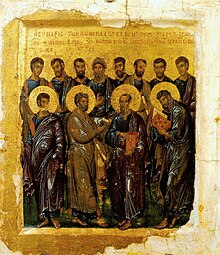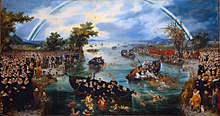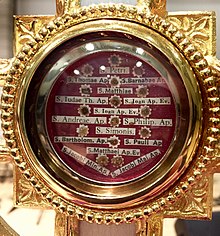
John the Apostle, also known as Saint John the Beloved and, in Eastern Orthodox Christianity, Saint John the Theologian, was one of the Twelve Apostles of Jesus according to the New Testament. Generally listed as the youngest apostle, he was the son of Zebedee and Salome. His brother James was another of the Twelve Apostles. The Church Fathers identify him as John the Evangelist, John of Patmos, John the Elder, and the Beloved Disciple, and testify that he outlived the remaining apostles and was the only one to die of natural causes, although modern scholars are divided on the veracity of these claims.
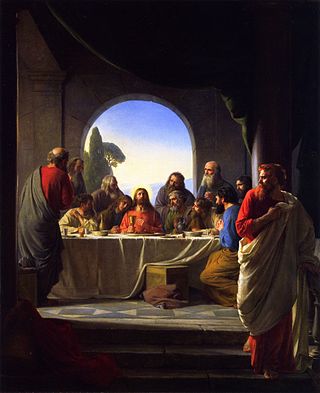
Judas Iscariot was—according to Christianity's four canonical gospels—a first-century Jewish man who became a disciple and one of the original Twelve Apostles of Jesus Christ. Judas betrayed Jesus to the Sanhedrin in the Garden of Gethsemane by kissing him on the cheek and addressing him as "master" to reveal his identity in the darkness to the crowd who had come to arrest him. Like Brutus, his name is often used synonymously with betrayal or treason.

James the Great was one of the Twelve Apostles of Jesus. According to the New Testament, he was the second of the apostles to die, and the first to be martyred. Saint James is the patron saint of Spain and, according to tradition, his remains are held in Santiago de Compostela in Galicia.

James the Less is a figure of early Christianity. He is also called "the Minor", "the Little", "the Lesser", or "the Younger", according to translation, James is styled "the Less" to distinguish him from the Apostle James the Great with "Less" meaning younger or shorter, rather than less important. James the Great was the brother of John the Apostle.

James the Just, or a variation of James, brother of the Lord, was a brother of Jesus, according to the New Testament. He was the first leader of the Jerusalem Church of the Apostolic Age. Traditionally, it is believed he was martyred in AD 62 or 69 by being stoned to death by the Pharisees on order of High Priest Ananus ben Ananus. James, Joses, Simon, and Judas are mentioned as the brothers or siblings of Jesus as well as two or more unnamed sisters.

Simon the Zealot or Simon the Canaanite or Simon the Canaanean was one of the most obscure among the apostles of Jesus. A few pseudepigraphical writings were connected to him, but Jerome does not include him in De viris illustribus written between 392 and 393 AD.

Jude was one of the Twelve Apostles of Jesus according to the New Testament. He is generally identified as Thaddeus and is also variously called Judas Thaddaeus, Jude Thaddaeus, Jude of James, or Lebbaeus. He is sometimes identified with Jude, the brother of Jesus, but is clearly distinguished from Judas Iscariot, the disciple who betrayed Jesus prior to his crucifixion. Catholic writer Michal Hunt suggests that Judas Thaddaeus became known as Jude after early translators of the New Testament from Greek into English sought to distinguish him from Judas Iscariot and subsequently abbreviated his forename. Most versions of the New Testament in languages other than English and French refer to Judas and Jude by the same name.

The seventy disciples, known in the Eastern Christian traditions as the seventy apostles, were early emissaries of Jesus mentioned in the Gospel of Luke.

According to the Gospel of John, Mary of Clopas was one of the women present at the crucifixion of Jesus and bringing supplies for his funeral. The expression Mary of Clopas in the Greek text is ambiguous as to whether Mary was the daughter or wife of Clopas, but exegesis has commonly favoured the reading "wife of Clopas". Hegesippus identified Clopas as a brother of Joseph. In the latest official edition of the Roman Martyrology of the Catholic Church she is commemorated with Salome on April 24th.

Matthew 10 is the tenth chapter in the Gospel of Matthew in the New Testament section of the Christian Bible. This chapter opens with Jesus calling some of his disciples and sending them out to preach and heal. This section is also known as the Mission Discourse or the Little Commission, in contrast to the Great Commission at the end of the gospel. The Little Commission is directed specifically to the "lost sheep of the house of Israel", while the Great Commission is directed to all nations. The Pulpit Commentary suggests that Jesus' message in this discourse "was hardly likely to have been remembered outside Jewish Christian circles".

Jude is one of the brothers of Jesus (Greek: ἀδελφοί, romanized: adelphoi, lit. 'brethren') according to the New Testament. He is traditionally identified as the author of the Epistle of Jude, a short epistle which is reckoned among the seven general epistles of the New Testament—placed after Paul's epistles and before the Book of Revelation—and considered canonical by Christians. Catholics and Eastern Orthodox Christians believe this Jude is the same person as Jude the Apostle; Catholics hold that Jude was a cousin, but not literally a brother of Jesus, while the Eastern Orthodox hold that Jude is St. Joseph’s son from a previous marriage.
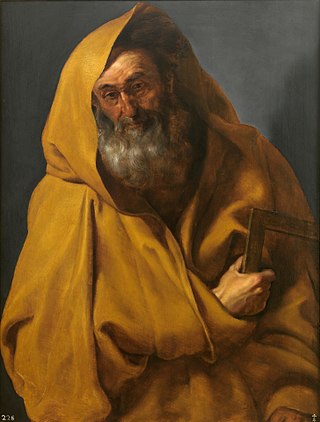
James, son of Alphaeus was one of the Twelve Apostles of Jesus, appearing under this name in all three of the Synoptic Gospels' lists of the apostles. He is generally identified with James the Less and commonly known by that name in church tradition. He is also labelled "the Minor", "the Little", "the Lesser", or "the Younger", according to translation. He is distinct from James, son of Zebedee and in some interpretations also from James, brother of Jesus. He appears only four times in the New Testament, each time in a list of the twelve apostles.

The Visual Bible: Matthew is a 1993 film portraying the life of Jesus as it is found in the Gospel of Matthew. The complete Gospel is presented word-for-word based on the New International Version of the Bible. It was directed by South African film maker Regardt van den Bergh and stars veteran actor Richard Kiley in the role of St. Matthew, newcomer Bruce Marchiano as Jesus, and Gerrit Schoonhoven as Peter. Marchiano portrays Jesus as a joyous, earthy, personal man with a sense of humour.

The commissioning of the Twelve Apostles is an episode in the ministry of Jesus that appears in all three Synoptic Gospels: Matthew 10:1–4, Mark 3:13–19 and Luke 6:12–16. It relates the initial selection of the Twelve Apostles among the disciples of Jesus.
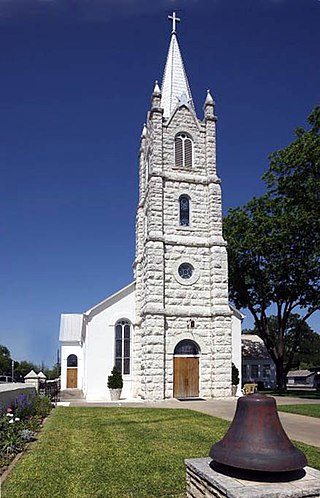
Zion Lutheran Church is located in Fredericksburg, in Gillespie County, in the U.S. state of Texas. It is the oldest Lutheran Church in the Texas Hill Country and one of the oldest in Texas. The church was built by six families in 1852. On January 13, 1853, twelve founders signed its articles of organization. The cornerstones for the church were set on March 6, 1854. Designated a Recorded Texas Historic Landmark in 1964, Marker number 10132.

Saint Peter, also known as Peter the Apostle, Simon Peter, Simeon, Simon, or Cephas, was one of the Twelve Apostles of Jesus Christ and one of the first leaders of the early Christian Church. He appears repeatedly and prominently in all four New Testament gospels as well as the Acts of the Apostles. Catholic tradition accredits Peter as the first bishop of Rome—or pope—and also as the first bishop of Antioch.

The name James appears 42 times in the New Testament. James was a very common given name in the historical period and region of Jesus, but surnames were still very rare. It is therefore not always clear which person these names refer to, and whether some refer to the same person or distinct characters, which has led to confusion. Therefore, Christian authors and modern scholars have given these men names based on their known attributes. According to American theologian and scholar Donald Hagner (2012), there are at least 5, and possibly up to 7, different Jameses in the New Testament.
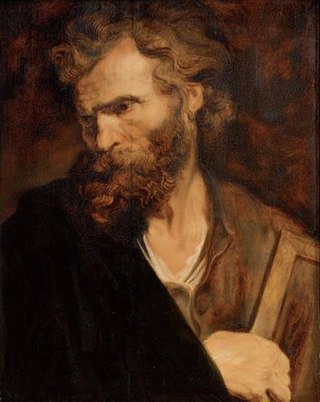
The names Judas and Jude, both derived from the Greek Ἰούδας (Ioúdas), itself derived from the Hebrew name Judah together appear 36 times in the New Testament. Judas was a very common given name in the historical period and region of Jesus, due to the renowned hero Judas Maccabeus. As surnames were still very rare, it is therefore not always clear which person these names refer to, and whether some refer to the same person or distinct characters, which has led to confusion. Therefore, Christian authors and modern scholars have given these men names based on their known attributes. 'Judas' is sometimes rendered as 'Jude' in English in order to help distinguish some of the people named Ἰούδας in the New Testament, even though the original Greek texts make no such distinction.



